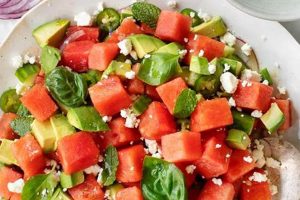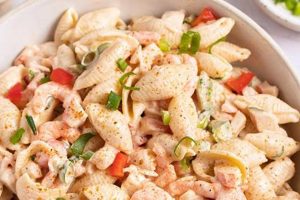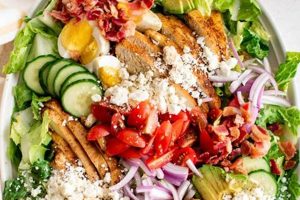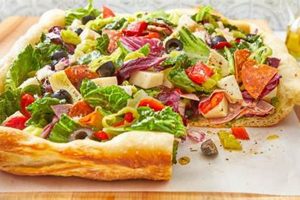A basic preparation of this dish typically involves cooked peas, often combined with mayonnaise, and other complementary ingredients like chopped celery, onion, or herbs. Variations might include bacon, cheese, or different dressings like vinaigrette. A straightforward approach emphasizes fresh, readily available ingredients and minimal preparation time.
Quick and easy to assemble, this type of salad offers a refreshing side dish, particularly suited for warm weather or potlucks. Peas provide a good source of protein and fiber, while other ingredients contribute to the overall nutritional value. Historically, pea salads, in various forms, have been a popular component of meals since refrigeration became more commonplace, allowing for convenient storage and serving of mayonnaise-based dishes.
Further exploration will cover variations, preparation techniques, tips for ingredient selection, and nutritional information relevant to crafting a delicious and wholesome dish.
Tips for a Delicious Pea Salad
Achieving a flavorful and well-balanced pea salad involves attention to detail and ingredient selection. These tips offer guidance for creating a satisfying culinary experience.
Tip 1: Use Freshly Cooked Peas: Fresh or frozen peas, cooked until tender-crisp, offer optimal flavor and texture. Canned peas, while convenient, can sometimes have a softer texture.
Tip 2: Balance Sweetness and Acidity: A touch of sweetness, from a small amount of finely diced red onion or a sprinkle of sugar, can complement the savory elements. A splash of vinegar or lemon juice adds brightness.
Tip 3: Incorporate Textural Variety: Crisp vegetables like celery, diced bell pepper, or water chestnuts add a satisfying crunch. Chopped fresh herbs like dill, mint, or parsley contribute a fresh element.
Tip 4: Choose the Right Mayonnaise: A good quality mayonnaise forms the base of the dressing. Consider using low-fat or olive oil-based mayonnaise for a lighter version.
Tip 5: Seasoning is Key: Salt, freshly ground black pepper, and a pinch of paprika or garlic powder can enhance the overall flavor profile. Taste and adjust seasonings before serving.
Tip 6: Chill Before Serving: Chilling the salad for at least 30 minutes allows the flavors to meld and enhances the refreshing quality of the dish.
Tip 7: Garnish Thoughtfully: A simple garnish, like a sprinkle of chopped fresh herbs, crumbled bacon, or a few slivered almonds, adds visual appeal.
By following these tips, one can create a pea salad that is both flavorful and visually appealing. Attention to detail, from ingredient selection to seasoning, ensures a successful and enjoyable culinary outcome.
These insights provide a foundation for successful preparation. The following section will conclude with suggestions for serving and variations.
1. Fresh or Frozen Peas
Pea selection significantly impacts the final quality of a simple pea salad. While canned peas offer convenience, fresh or frozen peas provide superior texture and flavor, contributing to a more satisfying dish. Understanding the nuances of these options allows for informed decision-making during recipe preparation.
- Flavor Profile
Fresh peas, especially when in season, offer a naturally sweet and vibrant flavor that enhances the overall taste of the salad. Frozen peas, when properly blanched and frozen quickly after harvest, retain much of this fresh flavor. This contrasts with canned peas, which can sometimes have a slightly metallic or bland taste.
- Textural Impact
Fresh and frozen peas, when cooked briefly, maintain a pleasant, tender-crisp texture. This desirable firmness contributes to the salad’s overall appeal. Canned peas, due to the canning process, often have a softer, mushier texture that can detract from the salad’s freshness.
- Nutritional Considerations
Fresh and frozen peas are generally considered to be nutritionally superior to canned peas. While canning preserves some nutrients, it can also lead to losses, particularly of water-soluble vitamins. Fresh and frozen peas retain more of their natural vitamin and mineral content.
- Preparation and Convenience
While fresh peas require shelling, frozen peas offer a convenient alternative, readily available year-round. Both options require brief cooking to achieve optimal tenderness. Canned peas, while the most convenient, often require rinsing to remove excess sodium.
The choice between fresh and frozen peas ultimately depends on availability, personal preference, and the desired outcome. Prioritizing fresh or frozen options ensures a brighter flavor and firmer texture, contributing significantly to the overall quality and enjoyment of a simple pea salad.
2. Complementary Vegetables
Complementary vegetables play a crucial role in enhancing the flavor, texture, and nutritional value of a simple pea salad recipe. Their strategic inclusion elevates the dish beyond basic peas and mayonnaise, creating a more complex and satisfying culinary experience. Understanding the interplay of various vegetables with peas allows for a more informed approach to recipe development and ingredient selection.
- Textural Contrast
The inherent sweetness and soft texture of peas benefit from the addition of crisp, crunchy vegetables. Celery, chopped red onion, and diced bell peppers offer contrasting textures, creating a more dynamic and enjoyable mouthfeel. Water chestnuts or chopped jicama can also contribute a refreshing crunch.
- Flavor Enhancement
While peas offer a delicate sweetness, complementary vegetables introduce additional flavor dimensions. The sharp bite of red onion, the subtle sweetness of chopped carrots, or the peppery notes of radishes create a more nuanced and balanced flavor profile. The choice of vegetables can be tailored to individual preferences and desired taste outcomes.
- Nutritional Value
Incorporating a variety of complementary vegetables increases the nutritional density of the salad. Different vegetables contribute different vitamins, minerals, and antioxidants. For example, carrots provide beta-carotene, while bell peppers are rich in vitamin C. This diversity enhances the overall health benefits of the dish.
- Visual Appeal
The inclusion of colorful vegetables enhances the visual presentation of the salad. The vibrant green of peas can be complemented by the bright red of diced tomatoes, the crisp white of chopped celery, or the deep orange of shredded carrots. This visual variety makes the salad more appealing and appetizing.
The careful selection and incorporation of complementary vegetables elevates a simple pea salad from basic to exceptional. By considering textural contrast, flavor enhancement, nutritional value, and visual appeal, one can create a well-rounded and satisfying dish that highlights the versatility of this classic recipe.
3. Mayonnaise-based dressing
Mayonnaise-based dressing forms the foundational element of a simple pea salad recipe, contributing significantly to its characteristic flavor, texture, and overall appeal. The emulsification of oil and egg yolks in mayonnaise provides a creamy, rich base that effectively binds the ingredients, coating the peas and other vegetables while delivering a smooth, palatable texture. This contrasts with vinaigrette-based dressings, which offer a lighter, tangier profile less commonly associated with traditional pea salad preparations. The inherent richness of mayonnaise complements the sweetness of peas, creating a balanced flavor profile. Furthermore, its viscosity allows for even distribution of seasonings and other flavoring agents throughout the salad.
Classic examples demonstrate mayonnaise’s centrality. Traditional American pea salad relies heavily on mayonnaise to achieve its creamy consistency and mild flavor. Variations incorporating bacon or cheese further benefit from mayonnaise’s ability to harmonize disparate ingredients. Even contemporary adaptations often retain mayonnaise as a core component, highlighting its enduring relevance in this culinary context. The ability of mayonnaise to act as a blank canvas for flavor customizationthrough additions like herbs, spices, or other condimentsunderscores its versatility. Substituting alternative dressings, while possible, often results in a dish that deviates significantly from the established understanding of simple pea salad.
Understanding the role of mayonnaise-based dressing proves crucial for achieving the desired outcome when preparing a simple pea salad. Its textural and flavor contributions cannot be easily replicated. Selecting the right type of mayonnaise, considering factors like fat content and flavor profile, further refines the final result. Successfully leveraging mayonnaise’s properties ensures a cohesive, flavorful, and recognizable pea salad experience, aligning with the established characteristics of this classic dish.
4. Simple Seasoning
Simple seasoning plays a crucial role in elevating the inherent flavors of a simple pea salad recipe without overwhelming the palate. The delicate sweetness of peas and the creamy richness of the mayonnaise-based dressing provide a neutral backdrop that benefits from careful seasoning. Overly complex or assertive spice blends can mask these subtle flavors, detracting from the refreshing simplicity of the dish. A judicious approach to seasoning enhances the overall taste experience, allowing the individual components to shine while creating a harmonious and balanced flavor profile. The concept of simplicity extends beyond the choice of seasonings to the quantities used. A light hand ensures that the seasoning complements rather than dominates the other ingredients.
Salt and freshly ground black pepper serve as the foundational seasonings in most simple pea salad recipes. Salt enhances the natural sweetness of the peas and balances the richness of the mayonnaise. Pepper adds a subtle layer of complexity and a mild bite. Beyond these basics, a few carefully chosen additions can further enhance the flavor profile without compromising the dish’s simplicity. A pinch of paprika adds a touch of smokiness and warmth. A small amount of garlic powder contributes a savory depth. Fresh herbs, such as dill, mint, or chives, offer a bright, refreshing counterpoint to the creamy dressing. Even a small amount of finely grated lemon zest can introduce a vibrant citrus note. These subtle additions, used sparingly, contribute to a more nuanced and satisfying flavor experience.
The practical significance of understanding the role of simple seasoning lies in its ability to transform a basic pea salad into a truly delicious and well-balanced dish. Proper seasoning elevates the inherent flavors of the ingredients, creating a harmonious and satisfying culinary experience. The restraint exercised in choosing and using seasonings preserves the refreshing simplicity that defines this classic dish. Attention to this seemingly minor detail significantly impacts the overall enjoyment and appreciation of a simple pea salad.
5. Minimal preparation time
Minimal preparation time represents a defining characteristic of a simple pea salad recipe, directly influencing its appeal and practicality. The speed and ease of assembly contribute significantly to the dish’s suitability for various occasions, from casual weeknight meals to larger gatherings. This efficiency stems from the readily available ingredients and straightforward preparation methods. Pre-cooked or frozen peas eliminate lengthy cooking processes. Chopping vegetables, combining ingredients with the dressing, and chilling constitute the majority of the preparation work. This streamlined approach allows for rapid assembly, making it a convenient option for time-constrained individuals or those seeking a quick and easy side dish. For instance, a simple pea salad can be assembled in under 15 minutes, contrasting sharply with more labor-intensive dishes.
The emphasis on minimal preparation time aligns with contemporary lifestyles, where convenience and efficiency often take precedence. This characteristic expands the recipe’s accessibility, appealing to individuals with varying culinary skills and time constraints. The ability to create a flavorful and satisfying dish with minimal effort adds to its overall value. Furthermore, minimal preparation time translates to less cleanup, a welcome benefit in any kitchen. This inherent efficiency contributes to the recipe’s enduring popularity and its frequent inclusion in potlucks, picnics, and other informal gatherings. Consider the scenario of a last-minute barbecue invitation: a simple pea salad can be quickly assembled and transported, offering a convenient and flavorful contribution without requiring extensive planning or preparation.
The practical significance of minimal preparation time in the context of a simple pea salad recipe lies in its ability to broaden the dish’s appeal and facilitate its inclusion in a variety of culinary settings. This efficiency directly contributes to the recipe’s enduring popularity and its suitability for both casual and more formal occasions. Understanding this connection allows individuals to leverage the convenience and simplicity of this classic dish, maximizing its utility in diverse culinary contexts.
6. Versatile Serving Options
The versatility of serving options contributes significantly to the enduring popularity of the simple pea salad recipe. Its adaptability to various culinary contexts, from casual meals to formal gatherings, stems from the dish’s inherent simplicity and compatibility with diverse flavor profiles. This adaptability expands the recipe’s utility, making it a valuable addition to a wide range of menus and occasions. An examination of specific serving scenarios highlights this versatility.
- Standalone Side Dish
A simple pea salad functions effectively as a refreshing and flavorful standalone side dish, complementing a variety of main courses. Its light, creamy texture and subtly sweet flavor profile pair well with grilled meats, roasted vegetables, or sandwiches. Consider a summer barbecue: a bowl of pea salad provides a cooling counterpoint to richer, heavier dishes. This adaptability makes it a valuable addition to any meal.
- Potluck Contribution
The ease of transport and serving makes simple pea salad an ideal potluck contribution. Its stability at room temperature eliminates concerns about food safety, while its vibrant color and fresh flavors make it a visually appealing addition to a buffet spread. The recipe’s scalability allows for easy adjustment to different serving sizes, accommodating both small and large gatherings. This practicality contributes to its popularity in potluck settings.
- Picnic Fare
The portability and refreshing nature of simple pea salad make it a natural choice for picnics and outdoor gatherings. Its ability to withstand warmer temperatures without compromising flavor or texture ensures a satisfying culinary experience in outdoor settings. The salad’s compatibility with various serving vessels, from disposable containers to reusable bowls, further enhances its portability. This aligns perfectly with the casual and informal nature of picnics.
- Part of a Larger Buffet
Simple pea salad integrates seamlessly into larger buffets, offering a lighter, refreshing option among potentially heavier dishes. Its versatility allows it to complement a wide range of cuisines and flavor profiles. Whether served alongside heartier salads, roasted meats, or more complex dishes, the simple pea salad offers a palate-cleansing and texturally contrasting element. This adaptability enhances its value in buffet settings.
The adaptability of simple pea salad to diverse serving scenarios underscores its versatility and contributes to its widespread appeal. From casual picnics to more formal buffets, the dish’s inherent simplicity and compatibility with various cuisines and flavor profiles ensure its relevance in a broad range of culinary contexts. This versatility makes it a valuable and reliable option for any occasion, solidifying its status as a culinary staple.
7. Nutritional Value
Nutritional value represents a significant aspect of a simple pea salad recipe, extending beyond its culinary appeal. Understanding the nutritional composition of this dish provides insights into its potential health benefits and its role within a balanced diet. While specific nutritional values vary based on ingredient choices and portion sizes, a general overview reveals key contributions to dietary intake.
- Vitamins and Minerals
Peas, the foundational ingredient, contribute essential vitamins and minerals. They offer a good source of vitamin K, crucial for blood clotting and bone health. They also provide vitamin C, an antioxidant supporting immune function. Furthermore, peas contribute folate, essential for cell growth and development, and manganese, supporting various metabolic processes. Complementary vegetables further enhance the vitamin and mineral profile. For example, carrots contribute beta-carotene, a precursor to vitamin A, promoting eye health. Red onion provides quercetin, a flavonoid with antioxidant properties.
- Fiber Content
Both peas and many common complementary vegetables, such as celery and carrots, contribute dietary fiber. Fiber promotes digestive health, aids in regulating blood sugar levels, and contributes to satiety, potentially assisting in weight management. The inclusion of fiber-rich ingredients enhances the nutritional value of the simple pea salad, making it a more filling and beneficial dietary choice.
- Protein Source
Peas offer a plant-based protein source, contributing to overall protein intake. While not a complete protein on its own, combining peas with other plant-based protein sources throughout the day can help meet dietary protein requirements. This aspect becomes particularly relevant for vegetarian or vegan diets, where plant-based protein sources play a central role. Adding ingredients like chickpeas or edamame to a simple pea salad further enhances its protein content.
- Healthy Fats (Potential)
The mayonnaise-based dressing contributes fat, primarily in the form of unsaturated fats. Choosing a mayonnaise made with healthy oils, such as olive oil or avocado oil, enhances the nutritional profile of the dressing. These healthy fats play a role in various bodily functions, including cell growth and hormone production. However, moderation is key, as even healthy fats are calorie-dense. Portion control remains essential for managing overall calorie intake.
The nutritional value of a simple pea salad recipe underscores its potential to contribute positively to a balanced diet. While variations exist based on specific ingredients and preparation methods, the dish inherently offers valuable vitamins, minerals, fiber, and potentially healthy fats. Understanding these nutritional contributions allows for informed choices regarding ingredient selection and portion control, maximizing the health benefits associated with this simple yet nutritious dish.
Frequently Asked Questions
This section addresses common inquiries regarding simple pea salad recipes, providing concise and informative responses to clarify potential uncertainties and enhance understanding of this classic dish.
Question 1: What type of peas is best suited for a simple pea salad?
Fresh or frozen peas generally yield optimal flavor and texture. Canned peas, while convenient, may have a softer texture and less vibrant flavor.
Question 2: Can the mayonnaise-based dressing be substituted with a vinaigrette?
While vinaigrette-based dressings can be used, they deviate from the traditional creamy profile of a simple pea salad. A lighter vinaigrette may not effectively bind the ingredients or complement the sweetness of the peas in the same way.
Question 3: How long can a simple pea salad be stored in the refrigerator?
Properly stored in an airtight container, a simple pea salad can typically be refrigerated for up to three days. Quality may degrade after this period.
Question 4: Can a simple pea salad be frozen?
Freezing is generally not recommended. The mayonnaise-based dressing can separate upon thawing, resulting in an undesirable texture. The vegetables may also lose their crispness.
Question 5: How can one reduce the overall calorie content of a simple pea salad?
Using low-fat or light mayonnaise, reducing the amount of added sugar, and incorporating a higher proportion of vegetables can contribute to a lower-calorie version.
Question 6: What are some common complementary ingredients beyond the basic celery and onion?
Chopped bell peppers, water chestnuts, shredded carrots, fresh herbs (dill, mint, chives), crumbled bacon, and chopped hard-boiled eggs represent popular additions.
Careful consideration of these frequently asked questions facilitates a more informed approach to simple pea salad preparation, ensuring a successful and satisfying culinary outcome. Addressing common concerns clarifies potential uncertainties and promotes a deeper understanding of this versatile and classic dish.
The following section will offer concluding remarks and summarize key takeaways for creating a delicious simple pea salad.
Simple Pea Salad Recipe
Exploration of the simple pea salad recipe reveals a dish characterized by accessible ingredients, straightforward preparation, and adaptable flavors. Emphasis on fresh or frozen peas, balanced seasoning, and a creamy mayonnaise base contributes to a consistently satisfying culinary experience. Nutritional value, derived from peas and complementary vegetables, further enhances the dish’s appeal. Minimal preparation time and versatile serving options solidify its practicality for diverse occasions.
Culinary exploration demonstrates the enduring relevance of the simple pea salad recipe within a broad range of culinary contexts. Adaptability to individual preferences and dietary considerations ensures continued enjoyment and adaptation across generations. Careful consideration of ingredient selection, seasoning, and complementary components allows for the creation of a dish that transcends basic categorization, offering a timeless and satisfying culinary experience.






